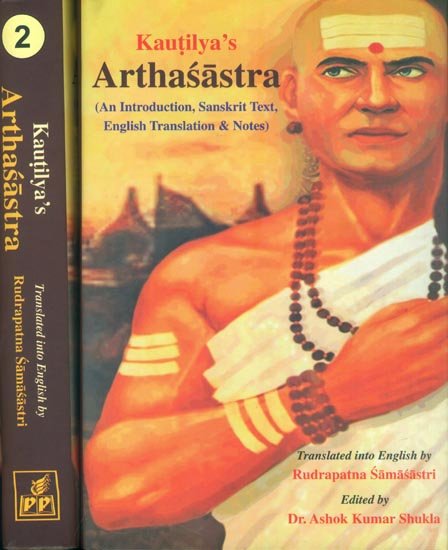Kautilya Arthashastra
by R. Shamasastry | 1956 | 174,809 words | ISBN-13: 9788171106417
The English translation of Arthashastra, which ascribes itself to the famous Brahman Kautilya (also named Vishnugupta and Chanakya) and dates from the period 321-296 B.C. The topics of the text include internal and foreign affairs, civil, military, commercial, fiscal, judicial, tables of weights, measures of length and divisions of time. Original ...
Chapter 2 - March of the Camp
[Sanskrit text for this chapter is available]
Summary: March of the Camp; and Protection of the Army in Times of Distress and Attack.
Having prepared a list of the villages and forests situated on the road with reference to their capacity to supply grass, firewood and water, march of the army should be regulated according to the programme of short and long halts. Foodstuffs and provisions should be carried in double the quantity that may be required in any emergency. In the absence of separate means to carry foodstuffs, the army itself should be entrusted with the business of carrying them; or they may be stored in a central place.
In front the leader (nāyaka); in the centre the harem and the master (the king); on the sides horses and bodyguards (bāhūtsāra); at the extremity of the (marching) circular array, elephants and the surplus army; on all sides the army habituated to forest-life; and other troops following the camp, the commissariat, the army of an ally, and his followers should select their own road: for armies who have secured suitable positions will prove superior in fight to those who are in bad positions.
The army of the lowest quality can march a yojana (5 5/44 miles a day); that of the middle quality a yojana and a half; and the best army two yojanas. Hence, it is easy to ascertain the rate of march. The commander should march behind and put up his camp in the front.
In case of any obstruction, the army should march in crocodile array in the front, in cart-like array behind, and on the sides in diamond-like array (i.e. in four or five rows, each having its front, rear and sides) and in a compact array on all sides. When the army is marching on a path passable by a single man, it should march in pin-like array. When peace is made with one and war is to be waged with another, steps should be taken to protect the friends who are bringing help against enemies, such as an enemy in the rear, his ally, a Madhyama king, or a neutral king. Roads with obstructions should be examined and cleared. Finance, the army, the strength of the armies of friends, enemies, and wild tribes, the prospect of rains, and the seasons should be thoroughly examined.
When the protective power of fortifications and stores (of the enemies) is on its decay, when it is thought that distress of the hired army or of a friend’s army (of the enemy) is impending; when intriguers are not for a quick march; or when the enemy is likely to come to terms (with the invader), slow march should be made; otherwise quick march should be made.
Waters may be crossed by means of elephants, planks spread over pillars erected, bridges, boats, timber and mass of bamboos, as well as by means of dry sour gourds, big baskets covered with skins, rafts, gaṇḍikā (?), veṇikā (?).
When the crossing of a river is obstructed by the enemy, the invader may cross it elsewhere together with his elephants and horses, and entangle the enemy in an ambuscade (sattra).
He should protect his army when it has to pass a long desert without water; when it is without grass, firewood and water; when it has to traverse a difficult road; when it is harassed by an enemy’s attacks; when it is suffering from hunger and thirst after a journey; when it is ascending or descending a mountainous country full of mire, water-pools, rivers and cataracts; when it finds itself crowded in a narrow and difficult path; when it is halting, starting or eating; when it is tired from a long march; when it is sleepy; when it is suffering from a disease, pestilence or famine; when a great portion of its infantry, cavalry and elephants is diseased; when it is not sufficiently strong; or when it is under troubles. He should destroy the enemy’s army under such circumstances.
When the enemy’s army is marching through a path traversable by a single man, the commander (of the invader’s army) should ascertain its strength by estimating the quantity of foodstuffs, grass, bedding, and other requisites, fire pots (agninidhāna), flags and weapons. He should also conceal those of his own army. ^Keeping a mountainous or river fortress with all its resources at his back in his own country, he should fight or put up his camp.
[Thus ends Chapter II, “March of the Camp; and Protection of the Army in Times of Distress and Attack,” in Book X, “Relating to War” of the Arthaśāstra of Kauṭilya. End of the hundred and thirtieth chapter from the beginning.]
